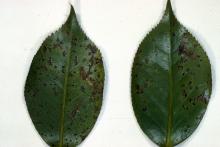See:
Geranium (Pelargonium spp.) - Oedema
Cause Physiological. Oedema (edema) is more prominent when air temperatures are lower than soil temperatures, soil moisture is high, and relative humidity is high. Low transpiration rates with an increase in water absorption increase cell pressure, erupting epidermal cells and allowing the inner cells to enlarge and protrude. This protrusion kills the cells and discolors them (yellow, brown, or rust), giving the impression that a parasitic organism is involved. Light levels, low nutrition, and high soil moisture each contribute to oedema development in Pelargonium sp. Also affected are Brassica, Dracaena, Fatshedera, Peperomia, and Polyscias. Other plants that can be affected include begonia, eucalyptus, hibiscus, hosta, privet, schefflera, and yew.
Symptoms This condition is usually found on lower leaf surfaces. The first symptom is few or numerous watery blisters or galls. Blisters or galls can turn a dark brown-yellow or rust color and look like a rust or bacterial infection. The undersides of camellia leaves develop brown, corky, roughened swellings. On foliage plants, lesions may be concentrated near the leaf margin. They also can be lighter than surrounding areas of the leaf.
Cultural control
- Reduce storage or growing humidity or soil moisture, if possible.
- Maintain proper fertility for the plant being grown.
References Daughtrey, M.L., Wick, R.L., and Peterson, J.L. 1995. Compendium of Flowering Potted Plant Diseases. St. Paul, MN: APS Press.
Horst, R.K. 2013. Westcott's Plant Disease Handbook, 8th ed. Netherlands: Springer Science+Business Media.

